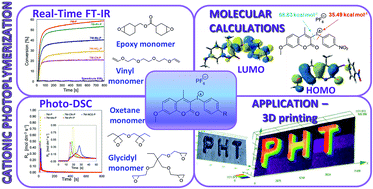One-component cationic photoinitiators based on coumarin scaffold iodonium salts as highly sensitive photoacid generators for 3D printing IPN photopolymers under visible LED sources†
Abstract
This paper describes the development of four new coumarin chromophore-based iodonium salts as efficient one-component cationic photoinitiators upon light-emitting diode (LED) irradiation with maximum emission under the UV-A region at 365 nm and under visible light at 405 nm. They initiate the cationic polymerization of epoxides, oxiranes, and glycidyl and vinyl ethers upon exposure to a UV-A LED and a visible LED. Even small structural variations of iodonium cations carrying different types of aryl moieties and the same coumarin chromophore can affect their properties. The properties and reactivities of a series of iodonium salts containing various cations were compared in the context of different photopolymerization processes. The relationship between the molecular structure of the coumarin-based iodonium salts and their reaction mechanism during the different photopolymerization processes was also investigated. Based on the results from real-time FT-IR spectroscopy and photo-differential scanning calorimetric experiments, it was concluded that the structures of the cations strongly affect the photopolymerization reaction rate and the final conversion of the monomer. Photopolymerization kinetic data show that kinetic parameters are affected by the presence of substituents in the phenyl ring of coumarin scaffold based iodonium salts. Indeed, the photoinitiating process remains highly efficient during the ring opening cationic photopolymerization of epoxides, oxiranes and glycidyl monomers, as well as during the extremely fast photopolymerization of vinyl monomers. The photochemical mechanisms of these new salts are investigated for the first time through electron spin resonance, laser flash photolysis and steady-state photolysis experiments and the cyclic voltammetry technique. Molecular orbital calculations are also used to shed some light on the initiation mechanisms. In conclusion, we have shown that new cationic iodonium photoinitiators are interesting from an industrial point of view because they can be used as efficient initiators in constructing IPN polymeric materials in the 3D printing area. These insights can encourage the utilisation of new coumarin based iodonium salts as useful photoinitiators in polymer coating synthesis, as well as for 3D printing processes.



 Please wait while we load your content...
Please wait while we load your content...